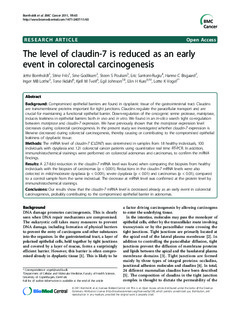The level of claudin-7 is reduced as an early event in colorectal carcinogenesis
Bornholdt, Jette; Friis, Stine; Godiksen, Sine; Poulsen, Steen S.; Santoni-Rugiu, Eric; Bisgaard, Hanne C.; Lothe, Inger Marie Bowitz; Andersen, Tone Ikdahl; Tveit, Magne Kjell; Johnson, Egil; Kure, Elin H.; Vogel, Lotte K.
Journal article, Peer reviewed
Published version

View/
Date
2011-02-10Metadata
Show full item recordCollections
Original version
Bornholdt, J., Friis, S., Godiksen, S., Poulsen, S.S., Santoni-Rugiu, E., Bisgaard, H.C., Lothe, I.M.B., Andersen, T.I., Tveit, M.K., Johnson, E., Kure, E.H. & Vogel, L.K. The level of claudin-7 is reduced as an early event in colorectal carcinogenesis. BMC Cancer, 2011, 11:65Abstract
BACKGROUND: Compromised epithelial barriers are found in dysplastic tissue of the gastrointestinal tract. Claudins are transmembrane proteins important for tight junctions. Claudins regulate the paracellular transport and are crucial for maintaining a functional epithelial barrier. Down-regulation of the oncogenic serine protease, matriptase, induces leakiness in epithelial barriers both in vivo and in vitro. We found in an in-silico search tight co-regulation between matriptase and claudin-7 expression. We have previously shown that the matriptase expression level decreases during colorectal carcinogenesis. In the present study we investigated whether claudin-7 expression is likewise decreased during colorectal carcinogenesis, thereby causing or contributing to the compromised epithelial leakiness of dysplastic tissue. METHODS: The mRNA level of claudin-7 (CLDN7) was determined in samples from 18 healthy individuals, 100 individuals with dysplasia and 121 colorectal cancer patients using quantitative real time RT-PCR. In addition, immunohistochemical stainings were performed on colorectal adenomas and carcinomas, to confirm the mRNA findings. RESULTS: A 2.7-fold reduction in the claudin-7 mRNA level was found when comparing the biopsies from healthy individuals with the biopsies of carcinomas (p < 0.001). Reductions in the claudin-7 mRNA levels were also detected in mild/moderate dysplasia (p < 0.001), severe dysplasia (p < 0.01) and carcinomas (p < 0.01), compared to a control sample from the same individual. The decrease at mRNA level was confirmed at the protein level by immunohistochemical stainings. CONCLUSIONS: Our results show that the claudin-7 mRNA level is decreased already as an early event in colorectal carcinogenesis, probably contributing to the compromised epithelial barrier in adenomas.